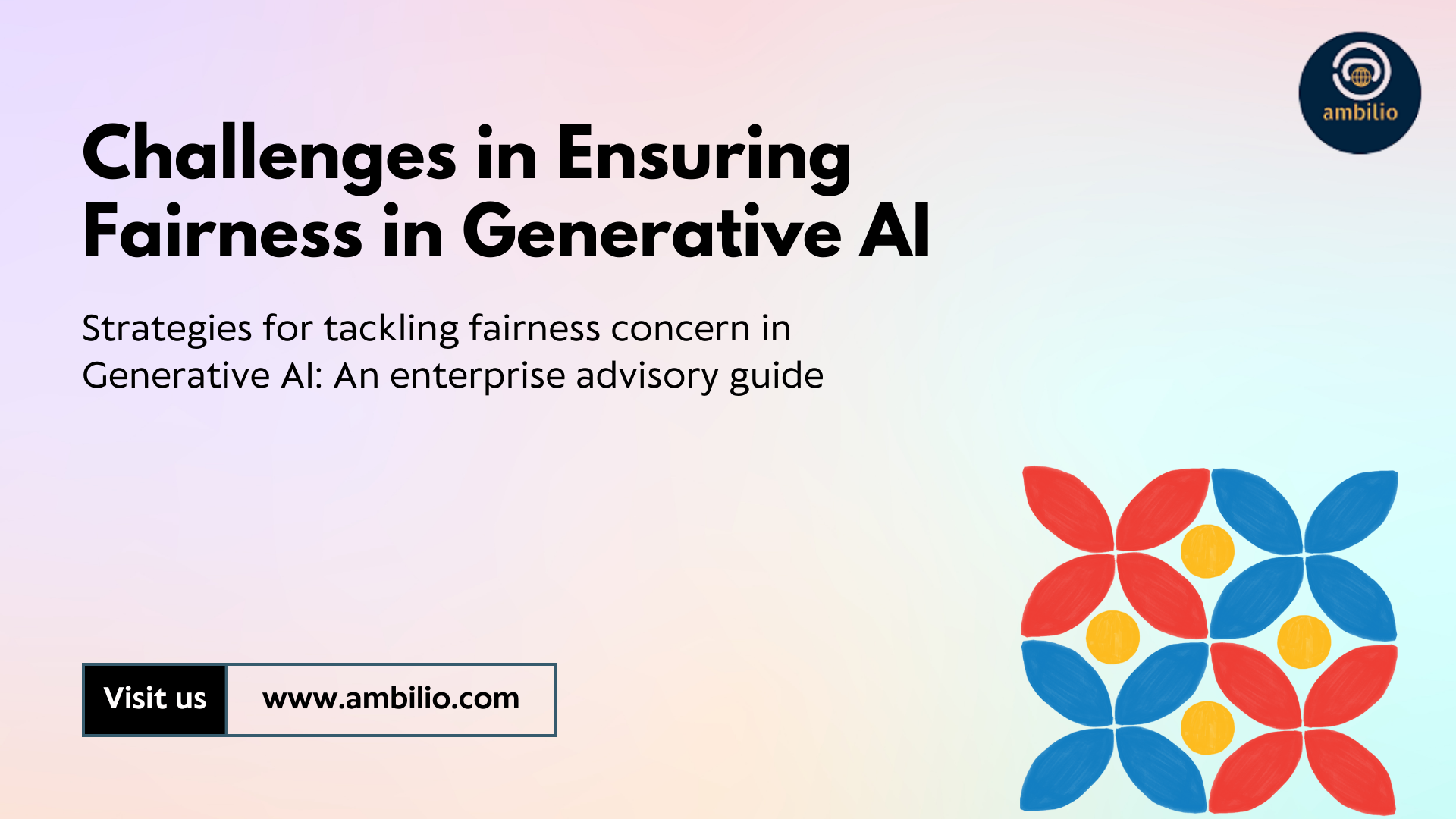Generative AI, particularly those systems powered by large language models (LLMs), is swiftly transforming various industries, from content creation to decision-making processes. However, these advancements introduce significant challenges, particularly in ensuring fairness and equity across applications. The rapid adoption of these technologies has heightened concerns about bias, representation, and ethical considerations. This guide explores the primary challenges enterprises face in maintaining fairness within generative AI systems and presents actionable strategies to address these issues, helping organizations develop more equitable and responsible AI-driven solutions in their respective fields.
Bias and Fairness in Generative AI
Bias is one of the most critical issues in generative AI. When AI systems are trained on data containing inherent biases—whether related to race, gender, socio-economic status, or other demographic factors—these biases can be learned and perpetuated, leading to unfair outcomes. For instance, in applications like hiring, biased AI can result in discriminatory practices, favoring certain groups over others. Similarly, in healthcare, biased AI may lead to disparities in the quality of care provided to different populations.
Solution:
To mitigate bias, enterprises must implement rigorous data pre-processing and post-processing techniques. This includes:
- Bias Auditing: Regularly audit training data to identify and eliminate biased samples. Automated tools and algorithms can assist in detecting biases, ensuring that the data fed into the AI model is as unbiased as possible.
- Algorithmic Fairness Techniques: Implement techniques like adversarial debiasing, which involves training the model with an additional adversary model that penalizes biased outcomes. This encourages the primary model to produce more equitable results.
- Fairness Metrics: Integrate fairness metrics into the model evaluation process. These metrics should complement traditional accuracy metrics, ensuring that fairness is a priority in model development.
The Need for Diverse and Representative Training Data
The effectiveness of generative AI models hinges on the diversity and representativeness of the training data. If the datasets lack representation from various demographic groups, the AI model will produce outputs that are skewed and fail to reflect the broader population. This can lead to unfair treatment of underrepresented groups, exacerbating social inequalities.
Solution:
Ensuring diverse and representative datasets involves several steps:
- Data Collection: Actively seek out data from diverse sources, including underrepresented communities, to build a more comprehensive dataset. This might involve collaborating with different organizations or utilizing data augmentation techniques to balance the dataset.
- Data Validation: Employ validation techniques to assess the representativeness of the dataset before training the model. This step is crucial in identifying gaps and ensuring that the data accurately reflects the diversity of the real world.
- Continuous Data Updates: Regularly update the training data to include new information, ensuring that the model remains relevant and fair as societal norms evolve.
The Pitfall of Ignoring Model Biases
One of the significant challenges in ensuring fairness is the tendency to overlook biases embedded within AI models. Ignoring these biases can result in the deployment of AI systems that generate biased or unfair outcomes, potentially leading to reputational damage and legal repercussions for the organization.
Solution:
Addressing model biases requires a proactive approach:
- Regular Bias Audits: Conduct regular audits of AI models to identify any biases that may have been introduced during training. These audits should be performed at various stages of the AI lifecycle to ensure that biases do not persist over time.
- Bias Mitigation Techniques: Implement bias mitigation techniques such as re-weighting, where the importance of biased samples is reduced during training, or equalized odds, which ensures that the model performs equally well across different demographic groups.
- Transparency and Explainability: Enhance model transparency by using explainable AI (XAI) techniques. This allows developers and stakeholders to understand how the model makes decisions, making it easier to identify and correct biases.
Balancing Accuracy with Fairness
Many AI systems are designed with a primary focus on accuracy, often at the expense of fairness. While high accuracy is essential, it is equally important to ensure that the model’s outputs are fair and do not disproportionately disadvantage any group. This narrow focus on accuracy can result in models that perform well in terms of predictions but fail to consider the ethical implications of their outputs.
Solution:
Balancing accuracy with fairness requires integrating fairness into the core objectives of AI development:
- Multi-Objective Optimization: Implement multi-objective optimization techniques that balance accuracy with fairness. These techniques enable the model to achieve high performance while also ensuring equitable outcomes across different groups.
- Fairness-Driven Model Design: Design AI models with fairness as a key consideration from the outset. This involves setting fairness constraints during model training and ensuring that these constraints are met alongside traditional performance metrics.
- Collaborative Decision-Making: Involve diverse teams in the AI development process to bring multiple perspectives to the table. This collaborative approach helps in identifying potential biases early in the development process and ensures that fairness is a priority throughout.
Complexity of Model Auditing
Generative AI models, particularly those based on LLMs, are inherently complex and open-ended, making them difficult to audit for fairness. The opacity of these models complicates efforts to define and enforce fairness metrics, leading to challenges in ensuring that the models behave ethically.
Solution:
Overcoming the complexity of model auditing involves:
- Automated Fairness Audits: Utilize automated tools to conduct fairness audits on AI models. These tools can analyze model outputs for signs of bias and provide detailed reports on potential fairness issues.
- Layered Auditing Approach: Implement a layered approach to auditing, where different aspects of the model are audited separately. This includes auditing the training data, model architecture, and outputs, allowing for a comprehensive assessment of fairness.
- Fairness Benchmarks: Develop and use standardized fairness benchmarks to evaluate AI models. These benchmarks can help in comparing different models and identifying those that best meet fairness criteria.
Navigating Ethical and Regulatory Considerations
As generative AI becomes more integrated into various sectors, navigating the ethical and regulatory landscape becomes increasingly complex. Developers must balance ethical responsibilities with compliance to emerging regulations, which can vary widely across regions and industries.
Solution:
Addressing ethical and regulatory challenges requires a well-structured approach:
- Ethical AI Frameworks: Develop and adhere to ethical AI frameworks that outline the principles and guidelines for responsible AI development. These frameworks should address issues of fairness, transparency, accountability, and inclusivity.
- Regulatory Compliance: Stay informed about the latest regulations governing AI use and ensure that all AI systems comply with these regulations. This may involve working with legal experts to understand the implications of regulations in different regions.
- Ethics Committees: Establish ethics committees within the organization to oversee AI development and deployment. These committees should include representatives from diverse backgrounds to ensure that all ethical considerations are addressed.
Continuous Monitoring and Feedback Mechanisms
AI models are not static; they require continuous monitoring and feedback to ensure that they remain fair over time. Without ongoing evaluation, models may drift, leading to biased outcomes as societal norms change or new data becomes available.
Solution:
Implementing continuous monitoring and feedback involves:
- Real-Time Monitoring: Set up real-time monitoring systems to track AI model performance and detect any signs of bias as soon as they occur. This allows for immediate intervention and correction.
- Feedback Loops: Establish feedback loops that allow users and stakeholders to report any biased or unfair outcomes generated by the AI. This feedback should be used to inform model updates and improve fairness over time.
- Regular Model Updates: Regularly update AI models to incorporate new data and address any biases that have been identified. This ensures that the models remain relevant and fair as societal expectations evolve.
Final Words
Ensuring fairness in generative AI is a multifaceted challenge that requires a comprehensive and proactive approach. By addressing the key challenges of bias, data diversity, model auditing, and ethical considerations, enterprises can develop AI systems that are not only effective but also fair and equitable. Continuous monitoring, transparency, and a commitment to ethical AI development are crucial in achieving this goal. As generative AI continues to evolve, prioritizing fairness will be essential in harnessing its potential for positive impact while minimizing harm.



